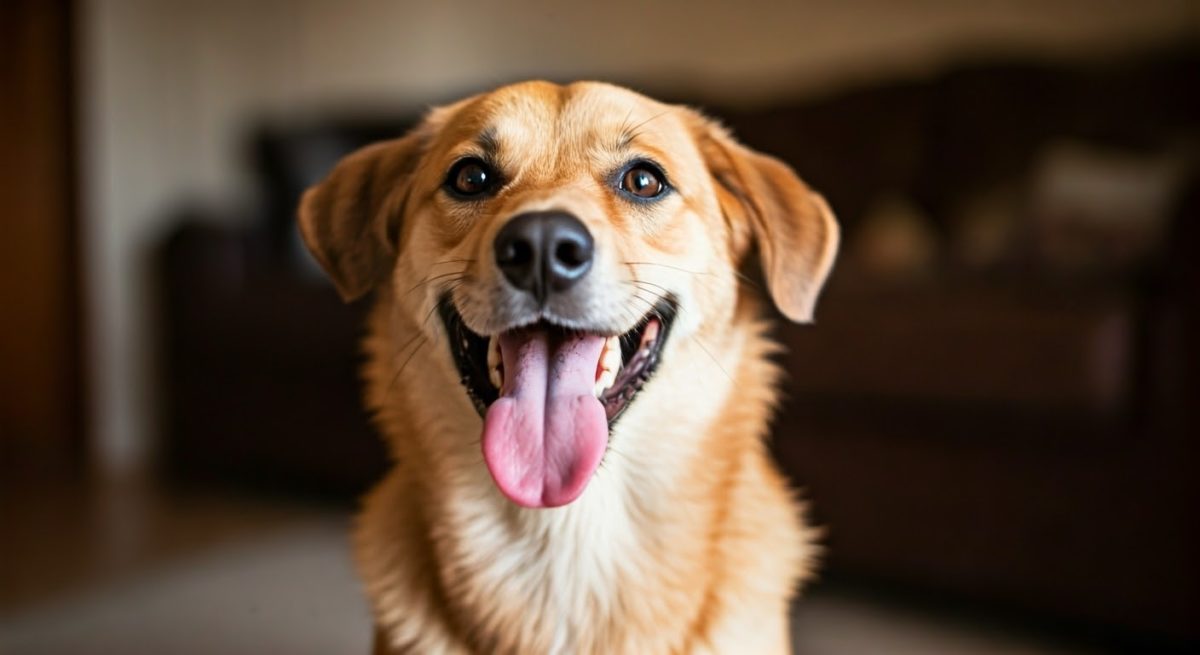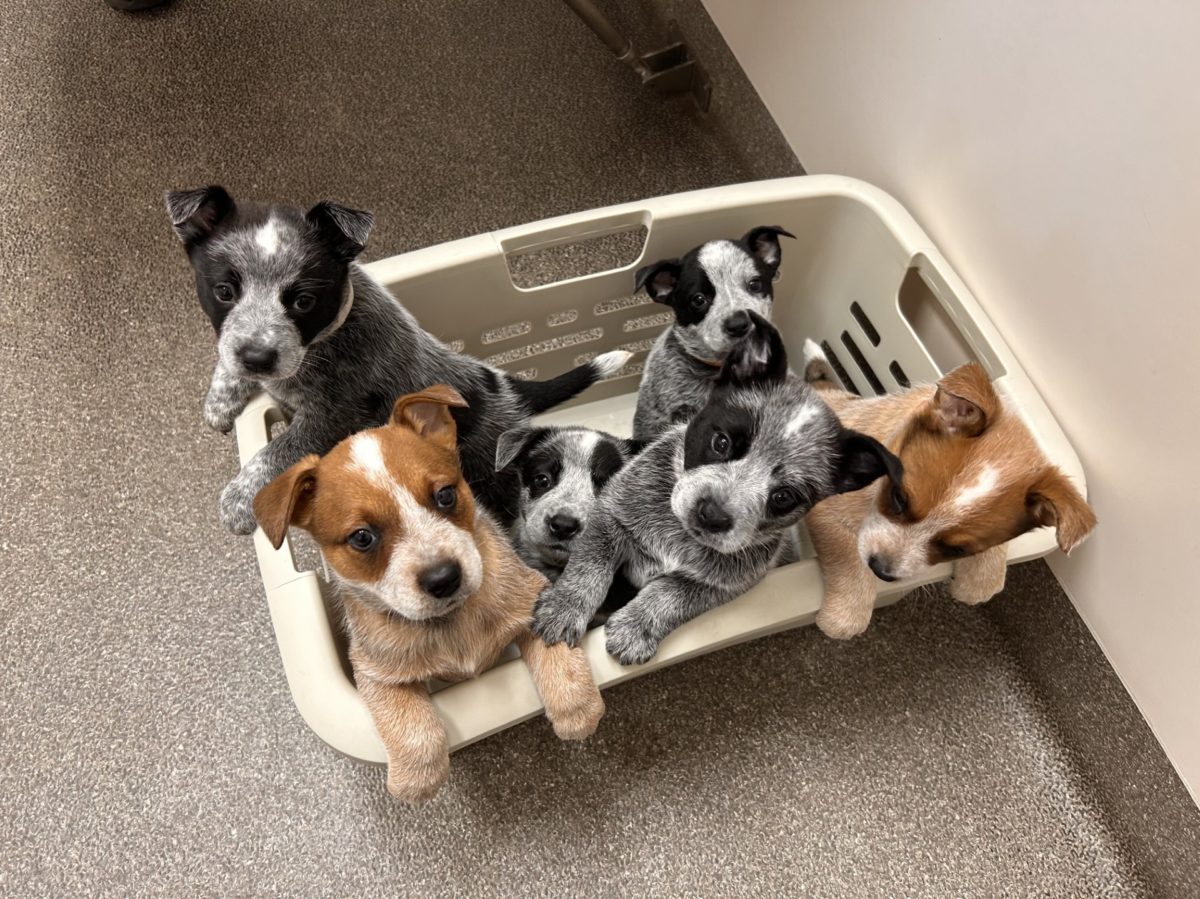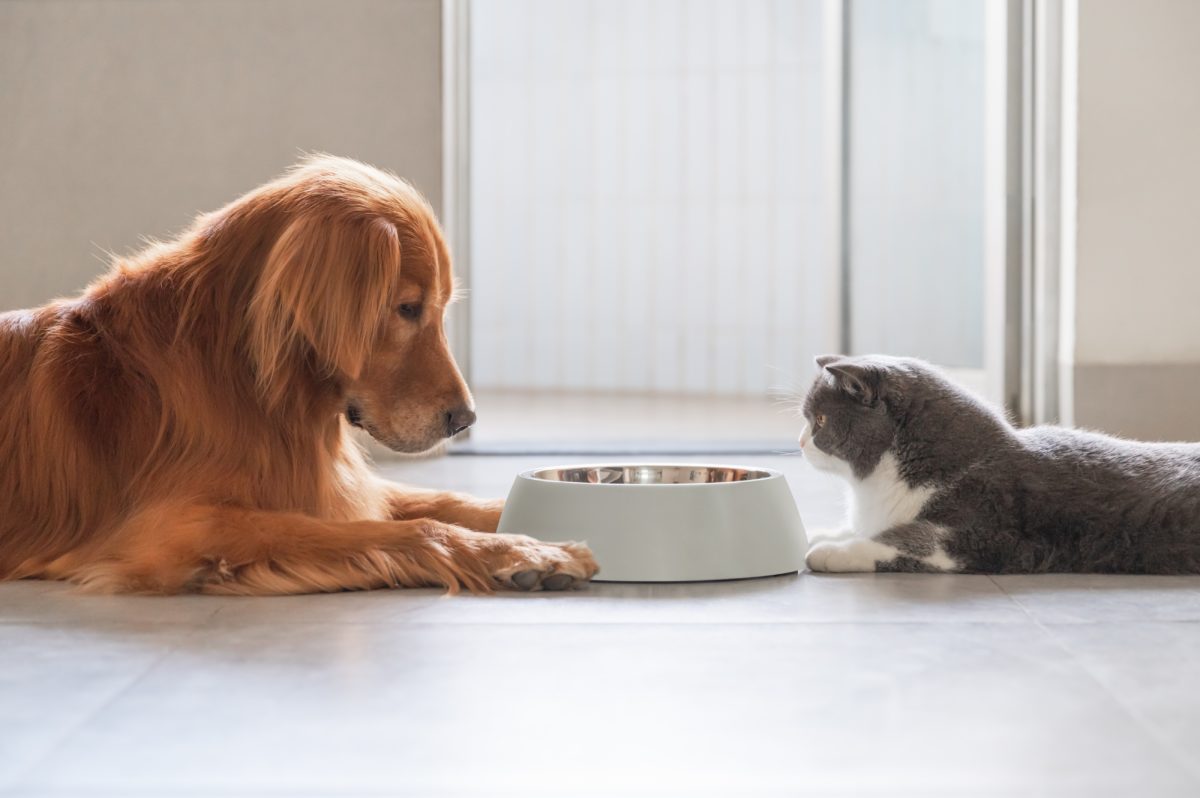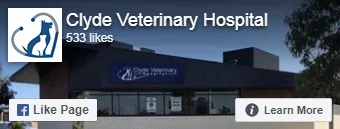Learn the signs, diagnosis, and treatment options for Cushing’s disease in cats. Discover how to spot early symptoms and when to consult your vet for personalised care.
Learn the signs, causes, and treatment options for Cushing’s disease in dogs. Understand how early diagnosis can improve your pet’s quality of life.
Border Collies are a breed like no other, known for their intelligence, agility, and work ethic. Originally bred to herd livestock, these dogs are energetic, eager to please, and often thrive in active environments. However, owning a Border Collie comes with unique challenges, particularly concerning their mental health, grooming needs, and potential health conditions. In this blog, we’ll delve into these aspects to help you provide the best care for your furry friend.
As pet owners, we all want our furry friends to be healthy and happy, but sometimes pets can face health issues similar to humans. One such issue is diabetes. While it may sound like something that only affects people, dogs and cats can also develop diabetes. If you’re wondering whether your pet can get diabetes, how to recognise the signs, and how to manage it, you’re in the right place.
Can My Dog Or Cat Get Diabetes? Are They Like Humans, Needing Insulin?
Yes, both dogs and cats can develop diabetes, and it can affect them similarly to how it affects humans. There are two main types of diabetes in pets:
- Diabetes Insipidus: This is a rare form of diabetes, often linked to hormonal imbalances. It’s different from the more common type but still something to be aware of.
- Diabetes Mellitus: This is the most common type of diabetes in pets, and it’s similar to type 2 diabetes in humans. Diabetes mellitus occurs when the body is unable to regulate insulin properly, either due to insufficient insulin production or the body’s inability to use it effectively. This causes a spike in blood glucose levels. Pets with this form of diabetes will often require insulin injections to help regulate their blood glucose levels.

What Do I Need To Look For If My Pet Is Diabetic?
Recognising the signs of diabetes early can help your pet avoid complications and lead to a more successful treatment. Some common symptoms to watch out for include:
- Increased Thirst and Urination: If you find yourself filling your pet’s water bowl more often or noticing an increase in accidents around the house, this could be a sign of diabetes. When blood sugar levels are high, pets will drink more to compensate for dehydration, and they may urinate more frequently.
- Weight Loss: Despite an increase in appetite, your pet may lose weight rapidly. This is because their body is not able to properly utilise glucose for energy, and it begins breaking down muscle and fat stores instead.
- Bad Breath: A distinct, sweet or fruity odor on your pet’s breath is often a sign of diabetes. This can occur when the body starts burning fat for energy due to a lack of glucose.
- Lethargy or Weakness: You may notice that your pet seems more tired or sluggish than usual. The lack of energy from glucose can cause them to be less active.
Why Do I Have To Treat Diabetes As Soon As Possible?
It’s crucial to treat diabetes in pets as soon as possible to avoid serious health complications. If left untreated, elevated blood glucose levels can cause a range of health problems, including damage to vital organs like the kidneys, liver, and eyes. Additionally, untreated diabetes can lead to a severe and life-threatening condition called ketoacidosis, where the blood becomes too acidic, leading to vomiting, lethargy, and potentially coma. Early intervention helps to stabilise blood sugar levels, preventing further complications and ensuring your pet’s long-term health.
What Do I Need To Look After My Diabetic Pet?
Managing a diabetic pet requires dedication, but with proper care, many pets can live happy and healthy lives. Here’s what you’ll need to do to care for your diabetic pet:
- Regular Insulin Injections: If your pet is diagnosed with diabetes mellitus, they will likely need insulin injections. This helps regulate their blood glucose levels. Your veterinarian will teach you how to administer the injections, and it’s essential to stick to the recommended schedule.
- Proper Diet: Feeding your diabetic pet the right food is key to managing their condition. A high-fibre diet that helps regulate blood sugar is often recommended. Work with your vet to determine the best diet plan for your pet’s specific needs.
- Monitor Blood Glucose Levels: Just like humans with diabetes, your pet’s blood glucose will need to be monitored regularly. Your vet will guide you on how to check their glucose levels at home and may suggest blood tests during vet visits.
- Exercise and Weight Management: Regular exercise is essential for diabetic pets, as it helps regulate blood sugar levels and maintain a healthy weight. However, any exercise plan should be tailored to your pet’s individual needs and abilities. Excess weight can worsen diabetes, so maintaining a healthy weight is crucial.
- Frequent Vet Checkups: Regular checkups with your veterinarian are essential for monitoring your pet’s condition. They will adjust insulin doses as needed, and keep track of any potential complications, ensuring the best care possible.
How To Prevent Diabetes In Pets
Preventing diabetes in your pets involves addressing the factors that contribute to the development of the disease. Although you can’t control genetics, there are steps you can take to minimise the risk:
- Maintain a Healthy Weight: Obesity is one of the most significant risk factors for diabetes in pets. Overweight pets are more likely to develop diabetes, as extra body fat can lead to insulin resistance. Keep your pet’s weight in check by feeding a balanced diet and engaging in regular physical activity.
- Encourage Regular Exercise: Physical activity helps keep your pet’s weight under control and promotes proper insulin use in the body. Daily walks for dogs and active playtime for cats are great ways to keep them moving and healthy.
- Provide a Balanced Diet: Feed your pet a nutritious diet tailored to their needs. High-quality pet foods that are low in carbohydrates and high in fibre can help maintain blood sugar levels. Limit treats, and avoid feeding them human food, which is often high in sugar or fat.
- Regular Vet Checkups: Regular veterinary visits are essential to monitor your pet’s health and detect any early signs of diabetes or other issues. This includes checking for early symptoms such as weight loss or excessive thirst, which can be indicators of diabetes.
- Limit Stress: Chronic stress can affect your pet’s overall health, including the development of diabetes. Ensure your pet has a stable environment with a predictable routine and plenty of opportunities for relaxation and play.
- Monitor for Early Signs: Keep an eye on your pet’s behaviour and health. If you notice any changes in appetite, thirst, or urination, or if they begin losing weight without reason, it’s essential to consult a vet right away. Early detection and treatment can prevent diabetes from becoming a more serious problem.
Conclusion
Just like humans, cats and dogs can develop diabetes, and managing the disease is vital to their health and well-being. Recognising the signs early, starting treatment promptly, and following the Clyde Veterinary Team’s recommendations can make a big difference. With proper care, your diabetic pet can lead a full, happy life. If you notice any signs of diabetes in your pet, don’t hesitate to contact Clyde Veterinary Hospital for a proper diagnosis and treatment plan.
Book an Appointment Today
Whether you’re looking for advice, reassurance, or a little extra guidance, the Clyde Veterinary Team is here to support you and your furry family members every step of the way. Reach out to us for expert care tailored to keep your pets happy, healthy, and thriving.
About the Author:
Dr. Irene Mitry is the owner and founder of Clyde Veterinary Hospital, and a vet with a difference. She has not one, but two veterinary degrees, and an abiding passion for preventative pet care. Her life-long love for our animal friends shines through in everything she does, as her client testimonials show. Dr Mitry’s long-standing desire to bring this philosophy of care to life in her own purpose-built veterinary clinic led her to found Clyde Veterinary Hospital in 2018.
Annual blood tests are a vital part of your pet’s healthcare routine, providing a baseline for comparison, enabling early detection of health issues, and uncovering hidden conditions before they become serious. From spotting early signs of disease to ensuring safe anaesthesia during procedures, regular bloodwork helps your pet live a longer, healthier life. Learn why prevention through routine testing is key to your pet’s well-being.
Discover how to choose the best food for your pet with this comprehensive guide. Learn about age-specific diets, dry vs. wet food, and how to monitor your pet's health through nutrition. Ensure your furry friend stays happy and healthy!
Giving your furry friend the best chance at living a longer, healthier life is the goal of every loving pet owner. Doing what’s best for your pet goes beyond ensuring they have access to good food, water & a comfortable environment.
Dental health care is often overlooked in pets and is of critical importance for their health & wellbeing. Did you know up to 85% of dogs or cats experience some form of dental health issue by just 3 years of age?
National pet dental health month is the perfect reminder of why it’s important to look after your pet’s teeth and gums. By recognising the signs of dental disease and taking steps to prevent it, you can help improve the quality of life for your pet for the years to come.
Recognising dental disease in pets: what is it and what does it look like
So why are teeth and gums so important to look after and what happens if they are not looked after?
Most dogs, cats and pocket pets are not born with bad teeth. In actual fact most young pets teeth will look clean, white and quite unremarkable. This can often be misleading because this may instil a false sense of security in pet owners; you may then ask yourself “My pets teeth are perfect, why should I bother to clean them”?
What is important to remember is that without regular brushing and possible dental heath care products (if required) over a period of month to years teeth WILL slowly accumulate plaque, followed by tartar with associated gingivitis.
A healthy mouth
A healthy pet’s mouth should show gums of a uniform light pink colour, with clear white teeth showing no discolouration or build up of plaque around the gums.
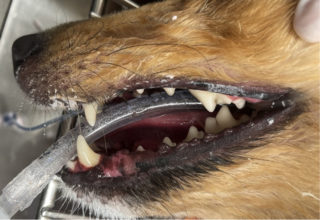
What is plaque?
Plaque is the first stage of dental disease and in animals is the pale yellow, light tan grimy film layer that coats the surface of teeth. Dogs, cats, pocket pets (and yes even humans!) that do not brush their teeth will accumulate this layer in a matter of hours. The composition of plaque itself is a mixture of microscopic food particles, saliva, oral bacteria, and minerals.
Plaque can in its earliest presentation be removed with regular toothbrushing. However if it is allowed to continue without proper dental care and removal it can form tartar.
This stage of dental disease is the most reversible and easiest to treat.
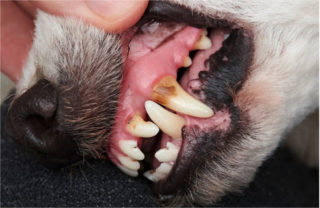
What is tartar?
Tartar is the next step in dental disease after plaque. It is plaque that has mineralised (calcified). Tartar can over time form continual layers on teeth and reach below the gum line to sit in the tooth socket. Tartar looks like a thickened brown film on the teeth with a craggy / raised ‘mountainous’ appearance. Because tartar is mineralised (and therefore very hard) it is not as amenable to tooth brushing for removal.
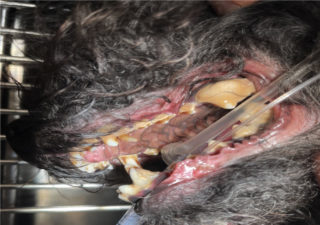
What is Gingivitis?
Once plaque and tartar are established on teeth and at the tooth / gum margin gingivitis will worsen. Gums are very sensitive tissues and chronic exposure to oral bacteria in plaque and tartar will cause a lot or redness, tenderness, inflammation, prone to bleeding with associated pain. It should also be remembered that red swollen, infected gums are more permeable to oral bacteria; which means that there is a higher chance of oral bacteria being absorbed into the bloodstream.
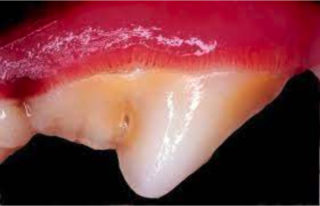
Tissues that can form bacterial inflammatory deposits include kidney and cardiac tissue. This may result in continual disease in these organs (example; kidney dysfunction or infections) or recurrent periods where your pet is unwell and “just not right”. The longer the dental disease continues untreated the more sickness episodes can be expected in our furry friends.
What happens with continual untreated dental disease?
End stage Periodontal Disease: Infected and loose teeth
Over time continual exposure of teeth and gums to bacteria will slowly erode the supporting ligament that holds teeth in place (the periodontal ligament); in time teeth will loosen and become mobile (wobbly) in their bony sockets. This increased gap in the space in-between the tooth and its socket allows further bacteria to sit in this space and accumulate.
In time the end stage of dental disease or “tooth decay” will become evident as teeth with pus around the gum / tooth margin with wobbly teeth that move whenever the pet eats.
Eventually the bony sockets of the upper and lower jaw that the teeth sit in become infected (osteomyelitis) with the bone changing into a more softer and fragile consistency.
Once the gums, teeth and mouth reach this later stage of dental disease it is often irreversible: meaning that dental cleaning and prophy treatments are recommended and instigated but these will not restore the teeth back to complete health and ongoing dental disease is expected in the future requiring ongoing care.
As expected this final stage of dental disease can be quite painful and reduce eating due to pain. Additionally brushing the teeth becomes more difficult due to the increased sensitively of the teeth to pain.
While plaque and tartar can often be seen by looking in your pet’s mouth, sometimes it can be hard to notice when you’re unsure what to look out for. As a general rule, don’t assume that your pet’s teeth are healthy without getting a pet dental health check and maintaining pet dental care.
Here are some common signs of dental disease:
- Bad breath
- Irregular/abnormal eating or drinking: eg. picking up food with their nouth then dropping it
- Broken/loose teeth
- Excessive drooling or pawing at mouth
- Bleeding from the mouth
- Teeth that are no longer white on the surface but are yellow or tan with a rough texture rather than a soothe surface
Benefits of Maintaining Pets Dental Health
By getting to it early, you minimise the likelihood of tartar forming and moving below the gum line and causing your pet serious pain and discomfort as a result of inflammation and infection.
Ensuring your pet receives proper dental care both at home and at the vet is vital. By practising proper dental care, pets are more likely to experience improved overall health that will help them in the years to come.
Pet dental health awareness month is the perfect time to book your best friend into your local veterinary clinic for a check-up.
At Clyde Veterinary Hospital, we provide dental health services for dogs, cats, rabbits, rodents and ferrets. We pride ourselves on treating animals in our state-of-the-art clinic and using gold standard service and dental equipment.
With dedicated dog and cat treatment areas, you can trust that your beloved pet will receive the highest quality, tailored care. We use the best pet dental care products and perform rigorous pre-anaesthetic testing to help ensure your pet receives the best treatment possible.
If your pet is showing signs of dental problems or you’d like to make sure your pet’s health is the best it can be, give us a call on 03 9052 3200 or make a booking online today.
What You Can Do?
Clean Their Teeth Regularly
Few pet owners take the time to give their animal’s teeth a regular or dedicated clean, but this is without question the gold standard in preventative care.
We strongly encourage the use of a dedicated species-specific toothbrush or “finger brush” which is a specially designed plastic overlay that you place over your finger and use to brush their teeth directly, and which gives much better tactile feedback and a better experience for your pet.

Using a dedicated dental paste is really the gold standard. Dedicated pet-specific formulations are available which have a palatable taste for pets, and which provide additional benefits such as mouth freshening and prevent plaque build-up.
We do recommend products such as Oxyfresh Pet Dental Gel, which is completely odourless and tasteless and made from natural ingredients.

We DO NOT recommend using human toothpaste to clean your dog or cat’s teeth, as these can contain ingredients that can be harmful to dogs or cats if used over an extended period and in some formulations contain ingredients which can be toxic to pets.
It’s important that you remain committed to a daily process of brushing in order to maintain the benefits of a regular dental regime, and it’s important to quickly get your pet used to the somewhat unnatural process of having their teeth brushed.
Here are some tips for gradual introduction to tooth brushing for your pet:
- Start by gently lifting up your dog or cat’s top and bottom lip one side at a time and lightly rubbing their teeth with your finger once a day. Once they become used to this, you should begin use of the finger or tooth brush.
- Once your pet is used to you handling their mouth and rubbing their gums, use the finger brush (WITHOUT) toothpaste to rub the gums. Brush with gentle circular motions.
- Finally introduce a small blob of toothpaste to your pet onto their gums before applying this onto the fingerbrush. This will get them used to the taste of the toothpaste. Then apply the toothpaste to the finger brush and start gently brushing each row of teeth, top and bottom left and right using circular motions. Concentrate on cleaning the outside (cheek-facing) surfaces, as most pets will not allow you to brush the inside (tongue facing) surface of the teeth. Be sure to clean the back upper molars and canines, as these teeth tend to quickly build up tartar.
Be sure to reward them after their toothbrushing with play, petting or a favourite activity, to positively reinforce the brushing process
We recommend starting your pet out as young as possible while they are still puppies or kittens, as they will be far more receptive to brushing if you begin at an early age.
Use Specially Formulated Dental Dry Food
A number of dog and cat food manufacturers now make several varieties of dry food formula which has been specially designed to abrasively prevent the build-up of plaque or tartar on your pet’s teeth and gums.
At Clyde Veterinary Hospital, we strongly recommend Hills Prescription Diet t/d Dental Care for Dogs and Cats –
This diet features a specially formulated, species-specific kibble shape and size, with “fibre matrix technology” for maximum plaque reduction. Essentially the kibble biscuits clean the teeth just by the pet chomping them up and eating them!
Hills t/d comes in a formulation for cats as well as various sizes for dogs
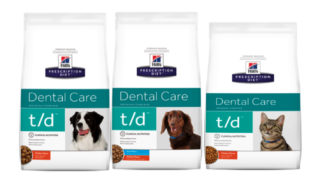
Use Dedicated Dental Chews
Similarly, several manufacturers make dedicated dental chew treats for dogs, which are a great-tasting way to supplement a daily brushing regime, and provide a little reward for putting up with the hassle of brushing.
Add a Specialised Dental Formula to Their Drinking Water
Oxyfresh have also come up with this extremely clever way of destroying bacteria and removing plaque – a dental additive solution you can mix in with their regular water – it’s completely colourless and odourless so they’ll never even know the good they are doing themselves every time they go to the water bowl – and it’s effective for both dogs and cats, or indeed any animal species.
We don’t recommend relying primarily on this as a preventative measure, but it can certainly help improve the effectiveness of a more hands-on dental care regime.

Give Dogs a Raw Bone
Although this is one preventative measure your dog will truly relish, we recommend exercising caution with this. Always supervise your pet when they are chewing a bone.
Importantly NEVER give your dog a cooked bone, as they are liable to splinter and can seriously injure your pet.
Always give your dog a human-grade meat bone (some preservatives used in inferior meats contain substances that can harm your dog), with enough meat still on to retain a degree of softness, and make sure the bone is large enough that they won’t attempt to swallow it.
Chewing on the bone’s rubbery surface can help remove plaque and tartar build-up and strengthen your dog’s gums, providing improved resistance to dental decay.
We recommend a maximum of 1-2 bones per week, and remember to try to leave a minimum 3 day gap between bone treats.
See Your Vet Regularly
This one may seem obvious, but it’s important that your pet has regular dental check-ups from an early age – you don’t want them having to live with a lifetime of tooth or other dental issues, which can lead to a loss of appetite, and restrict their enjoyment of life.
Only a professional dental check can properly diagnose and treat the often deeply hidden teeth or gum issues that can lurk deep within your dog or cat’s mouth.
Animals will also benefit from dental scaling, and your vet can advise if this would be appropriate and beneficial for your pet. Depending on the level of build-up, some dogs may need a yearly scale and polish.

Ultrasonic scalers are handheld devices which use ultrasonic vibrations to remove hard, calcified deposits from your pet’s teeth. They also create shockwaves that disrupt bacterial growth, while also washing and flushing pockets between teeth and any exposed root surfaces with water.
The procedure is usually followed by a professional tooth polish, which smooths the surface of the tooth to minimise bacteria and plaque build-up.
We do strongly caution against any lay dental practitioners who claim to perform dental scaling free of anaesthesia. For starters, the procedure can be painful and distressing for your pet, but just as importantly – it’s been shown to be ineffective as a preventative measure – in most cases, your pet is simply not going to allow anyone to insert anything deep enough into their mouths to provide for a complete and effective clean.
A Team You Can Trust at Clyde Vet
We have a team of trusted veterinarians who are leaders in pet care.
We value preventative care to keep your pet healthy and endeavour to identify any concerns before they become a bigger issue.
Book an Appointment Today
Our pets are an integral part of the family and we want to keep them safe and healthy at all times. If you have a pet you need to be aware that something as simple as feeding them the wrong food could lead to serious problems.
Familiarising yourself with common pet poisons in your animal is advisable to prevent potential toxicities. If poisoning should occur, it is also beneficial to recognise that the substance is toxic in order that prompt veterinary treatment can be sought.
If you suspect that your pet has ingested something dangerous, it is essential you visit a vet straight away. Better to be safe than sorry when it comes to your beloved pet.
Understanding toxic foods for pets
Certain human foods can cause severe health problems if ingested by a pet. In some extreme circumstances, the wrong food can be life-threatening. Certain foods can be more toxic to one species than another, so it’s important to familiarise yourself with what is safe.
Common Toxins in Cats:
There are several foods toxic to cats that can cause a range of health problems, some even life-threatening if consumed.
Onions, garlic, chives, and leeks
Onions are part of the Amaryllidaceae family. This genus Allium also includes garlic, chives, and leeks.
Allium species contain sulfoxides (sulfur-containing compounds), which are readily absorbed by the gastrointestinal tract and when absorbed into the bloodstream disrupt red blood cell membranes, resulting in red blood cell rupture which can result in anemia. As little as 5g/kg (or 20g in the average-sized 4kg cat) is enough to cause toxicity.
Breakdown products from red blood cell rupture may also result in kidney damage or failure.
Cats remain more sensitive to this form of poisoning than dogs (although this remains a toxic risk in dogs).
Signs to look for: Weakness, lethargy, pale gums, collapsing, vomiting.
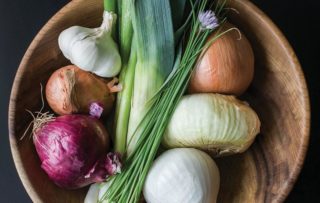
Grapes, currents, raisins and sultanas
While the exact mechanism of toxicity and amount required to produce this remains unknown this food group is known to cause kidney damage and, in some cases, can result in kidney failure.
Signs to look for: lethargy, vomiting, diarrhoea inappetence, seizures.
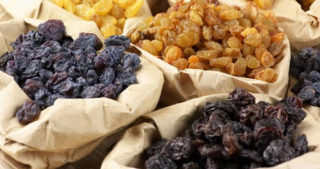
Feeding exclusively fish, particularly if cooked or smoked (eg. salmon, tuna)
Feeding a diet comprised solely of fish is not advised in carnivores as this can result in Thiamine (Vitamin B1) deficiency. Thiamine is essential to carbohydrate, amino acid, and fatty acid synthesis and metabolism. Thiamine can be destroyed by heat, sulphur preservatives, and in diets high in thiaminase (an enzyme that breaks down Thiamine) such as raw fish. Thiamine deficiency results in progressive neurological signs with the brain being particularly vulnerable as it requires Thiamine for many critical cellular processes.
Signs to look for: Early onset vomiting and inappetence followed by possible seizuring, impaired vision, weak or wobbliness on legs, head tilt.
Dairy Products
Many dogs and cats are lactose intolerant, which means that dairy products consumed can cause gastrointestinal upset. Milk is only required in the nursing stages of puppies and kittens under 6 weeks of age. Therefore, if milk is desired as a dietary addition in an adult animal a pet milk is advised (eg. Whiskas Milk Plus Lactose Free milk for Kittens & adult cats).
Dog food
While dog food might not be toxic, it can lead to nutritional deficiencies and imbalances if consumed by cats. Generally dog food contains insufficient levels of the following nutrients required in cats:
Protein: Cats are strict carnivores requiring a higher protein diet than dogs (which are omnivores eating both meat and plant-based material). Most commercial dog foods are too low in protein to meet a cat’s protein requirement. Likewise feeding a cat a “vegetarian” or “vegan” diet is dangerous and completely inappropriate for their metabolic needs and will result in severe illness and death if continued to be fed.
Signs to look for: inappetence, weakness, lethargy, seizures, coma
Remember a cat does not have a choice in what it eats and must consume meat! Pet owners’ beliefs should not be forced on our pets at the cost of their health and well-being.
Taurine: Cats, like people, cannot make their own taurine naturally in their bodies. Cats must therefore obtain taurine from their diet. Most dog foods do not have a high enough taurine content for cats. Signs of taurine deficiency include digestive upset, loss of vision, and heart problems.
Niacin: Cats are also unable to make their own niacin vitamin within their body. Animal tissue is high in niacin, so a high-protein diet is also required in this respect.
Vitamin A: Again, cats cannot produce their own Vitamin A and must obtain it from their diet. Dog food is too low in this vitamin for cats. Signs of Vitamin A deficiency include weak muscles, dull hair coat and night blindness.
Arachidonic acid: This fatty acid is unable to be produced naturally in cats whereas dogs create arachidonic acid themselves. Dog food, therefore, contains lower amounts than cat food. Signs of deficiency can include liver and kidney disease and various skin diseases.
Acetaminophen (Paracetamol)
If you feel your cat is in pain it is often best to consult a veterinarian before administering home medications.
Acetaminophen (Paracetamol) is highly toxic to cats due to their inability to metabolise this drug due to their body lacking the required enzymes. In order for cats to metabolise Acetaminophen they must use another metabolism pathway which results in toxic metabolites (breakdown products) being produced.
Toxicity is characterised by two processes:
- The inability of red blood cells to carry oxygen around the body results in low oxygen and collapse with blue/dark gums and struggling to breathe. This may also result in kidney damage
- Liver toxicity with liver tissue damage and failure
In cats, toxicity can occur with as little as 40mg of Paracetamol ingested in an average 4kg cat! Compare this to dogs where toxicity can occur in the same size 4kg dog but with a minimum toxic ingestion of 400mg. This illustrates the cat’s sensitivity to this toxin and marked inability to process it.
Signs to look for: Dark brown/muddy gum colour or blue gum colour, increased heart rate and respiratory rate, weakness, collapsing, depression, weakness, vomiting, hypothermia, yellow gums or skin (icterus), facial or paw oedema (fluid swelling)
Common Toxins in Dogs:
As dogs love wandering around the home trying to find food, it’s important to be mindful of what food is in reach. There are many toxic foods for dogs that you may have around your home and yard without even realising.
Macadamia nuts
The process involved in producing toxicity from macadamia nuts remains unknown however even consuming small amounts of these can lead to very serious illness. It should also be kept in mind that macadamia nuts can be coated in other products that are toxic to pets such as chocolate, xylitol sweetener, and grape products.
Signs to look for: weakness, staggering, vomiting, tremors, hyperthermia.

Chocolate
While chocolate is a toxic food for dogs and cats, dogs are more likely to be affected as cats are usually too discriminating to eat chocolate in large quantities.
The severity of chocolate toxicity depends on the type of chocolate ingested, the amount and the size of the pet.
Chocolate contains methylxanthines; namely theobromine and caffeine
Darker and more bitter chocolate (eg. higher percentage cocoa and cooking chocolate) contains more theobromine and caffeine and hence tends to be more toxic than milk and white chocolate but again this will depend on the quantity consumed.
It is also worth remembering that some chocolate products contain other toxins such as coffee beans, macadamia nuts, raisins and xylitol.
Signs to look for: hyperactivity, increased heart and respiratory rate, vomiting, diarrhoea, increased thirst, hyperthermia, tremors, and seizures.
Xylitol
Xylitol is a sweetener used as a sugar substitute in many pharmaceuticals, oral care products and as a food additive. It is found naturally in fruits such as berries and plums as well as corn, oats, mushrooms, lettuce and many trees. Commercially used Xylitol is extracted from corn fibre or birch trees and has gained popularity as a sugar substitute due to its low glycaemic index and dental plaque fighting properties.
Products containing xylitol include:
- Oral care products (eg. Mouthwash, toothpaste, sugar-free gum, breath mints)
- Foodstuffs (eg. Candy, baked goods, peanut butter, pudding snacks)
- Supplements and over-the-counter medications (eg. cough syrup, chewable or gummy vitamins, nasal sprays, skin care products, laxatives, digestive aids, allergy medications, mouth lozenges, sleep supplements)
- Pharmaceutical medications especially those formulated as quick-dissolve tablets or liquids.
Xylitol is extremely toxic to dogs. The Xylitol is absorbed into the bloodstream which causes a rapid release of insulin from the pancreas which results in a marked drop in blood sugar (hypoglycaemia) which can be life-threatening. Xylitol is also known to cause seizures as well as liver failure however this process is poorly understood.
Signs to look for: vomiting, lethargy, weakness, wobbliness, tremors, seizures, coma.
Are plants dangerous to pets?
Certain plants contain toxins that can cause a range of health problems if ingested ranging from mild to severe.
Familiarise yourself with what houseplants are toxic to pets so you know what plants to keep away from your home. You should also make sure there are no toxic plants growing in your garden that could be a problem for your pets.
Lilies
Lilies are one of the most common toxic plants for cats. Ingestion of any part of this plant (flower, stamen, leaves or stems) can cause kidney failure.
All members of the genera Lilium and Hemerocallis should be considered nephrotoxic to cats and potentially dogs. This includes the Easter lily (Lilium longiflorum), tiger lily (Lilium species) and daylily (Hemerocallis species), among many others.
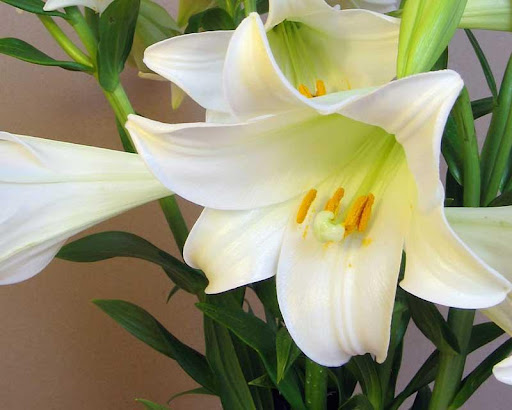
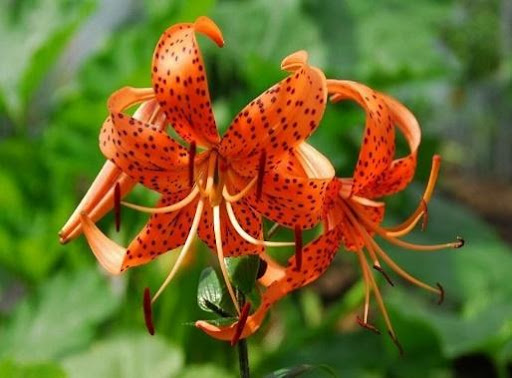
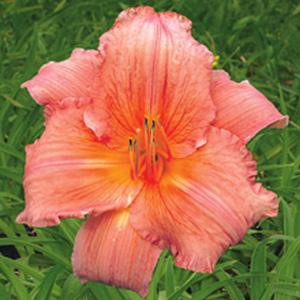
Signs to look for: Initial depression, vomiting, inappetence. If allowed to progress lily toxicity can result in kidney damage and failure.
Sago palm
Part of the Cycad/Cycas, Microzamia or Zamia genus these palms are also known as Coontie palms, Cardboard palms, Japanese cycad, Cycads, or Zymias, sago palms and are readily available for purchase in stores ranging from small nurseries to the garden sections of large home improvement stores. All parts of the sago palm plant are toxic.
Signs to look for: Gastrointestinal irritation with depression, drooling, vomiting and diarrhoea. Neurological signs including weakness, wobbliness, tremors, and seizures. If left untreated advanced signs may include liver damage with yellow skin or eyes (icterus), increased thirst and urination and dark urine. With liver disease decreased blood clotting may also occur resulting in bleeding both internally and externally.

Aloe vera
While aloe vera can be beneficial to humans, it can cause vomiting, diarrhoea, and digestive upset in dogs and cats if ingested.
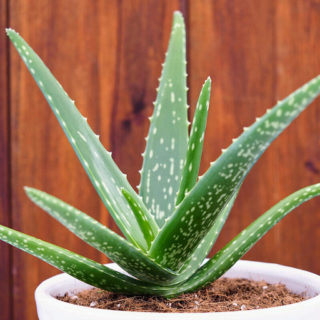
Azalea and Rhododendron
Azaleas and Rhododendrons are classified as part of the same family with all parts of the plant including the flower, leaves and shrub being toxic.
These plants contain a toxin called grayanotoxin, which disrupts the electrical pathway in muscle tissue including heart muscle.
Signs to look for: Gastrointestinal signs: inappetence, drooling, vomiting diarrhoea, abdominal pain. Cardiovascular signs: abnormal heart rate, low blood pressure, Neurology signs: depression, muscle tremours, blindness, seizures, coma.
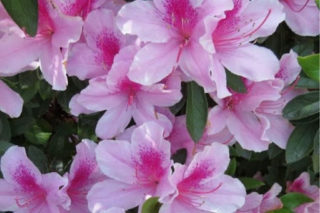
It is important to note that these lists are by no means exhaustive and there may be other toxins that may cause potential health concerns in your pet.
What to do if your pet is unwell?
Contact your veterinarian immediately for guidance on the best course of action. Observe any symptoms and follow your vet’s recommendations for treatment, which may include medication, rest, or changes to their diet or environment. Prompt intervention can be crucial for a successful recovery, so don’t hesitate to seek help if you have concerns about your pet’s health.
A vet you can trust at Clyde Veterinary Hospital
We have a team of trusted veterinarians who are leaders in pet care.
We value preventative care to keep your pet healthy and endeavour to identify any concerns before they become a bigger issue.
If you have any questions or would like to book an appointment please give us a call at (03) 9069 4088 or email us at info@clydevet.com.au





